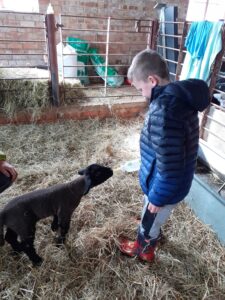The Need
Lapwing Education was founded in 2010 as an alternative education provider for students in Suffolk, Norfolk and Essex, focused on delivering bespoke individual and small group provision to young people with complex additional needs. Students have often struggled to manage in a mainstream, pupil referral unit or special school or college placement and may have learning difficulties or disabilities and social, emotional and mental health needs. Lapwing currently works with 60 young people aged from 4 to 25 who experience barriers to accessing education, employment and society, working with them to focus on personal and academic development including GCSEs, functional skills, vocational learning and work placements. Lapwing Education doesn’t have a base that students attend, instead staff go out into the community across East Anglia to work with students at a range of different settings.
Lapwing also runs grant-funded initiatives such as the Minding The Gap project (funded by the Big Lottery and the European Social Fund) which seeks to re-engage around 200 of the hardest to reach 15 to 24-year- olds in Suffolk who are not in education, employment and training and, through employing a range of approaches and delivery partners, move them back into education, training or work.
Many of the young people that Lapwing works with have had negative experiences of education and find it hard to trust adults, so establishing a relationship with them is an important starting point in their journey with the charity.
The Result
The Thrive Approach® is at the heart of Lapwing Education’s student programmes, creating a meaningful connection between staff and students that helps young people begin to regulate their emotions in a safe, supported way. Staff use the Thrive Vital Relational Functions (VRFs) to attune to and validate young people’s experiences and emotions, which deepens and strengthens their relationship with tutors, allowing staff to develop a bespoke programme to meet the needs of the individual.
 “For many of our students, their experiences of education have been difficult and they may have already felt rejected or failed by a variety of different provisions and services. For them, we can be just another person coming in - and expected to walk out - of their lives. As the Thrive Approach so strongly advocates, relationship and connection are key. This is where we begin our journey with all our new students – getting to know them as unique individuals, not just what has been written on a piece of paper,” said Lead Tutor Kerry Lawn, pictured top.
“For many of our students, their experiences of education have been difficult and they may have already felt rejected or failed by a variety of different provisions and services. For them, we can be just another person coming in - and expected to walk out - of their lives. As the Thrive Approach so strongly advocates, relationship and connection are key. This is where we begin our journey with all our new students – getting to know them as unique individuals, not just what has been written on a piece of paper,” said Lead Tutor Kerry Lawn, pictured top.
“It’s important to us that students reflect on their emotions and that they can think about where they want to be next. We use the Thrive Approach to empower our students to help them gain self-awareness and an understanding of the choices that are open to them. Our aim is that students learn for themselves to identify and realise their needs.”
Lapwing currently has three Licensed Practitioners®, with plans to train two additional members of staff. Inset days are used to give all staff an awareness of Thrive®, with new team members given a guide to the Approach along with a one--to-one induction session to help them to manage crisis situations, in particular, and ongoing support given to individual staff members as required.
Within a few weeks of starting with Lapwing, students are profiled using the Thrive-Online ™ (TOL) assessment tool. This identifies areas of need in their social and emotional development and suggests an action plan to help students to make progress. Learners are profiled every half-term using TOL so that their progress can be monitored and their action plans updated as they move forwards. Because this data benchmarks and documents progress it is also used by Lapwing Education, along with additional assessments, to evidence its impact to funders, including local authorities and schools.

Of the students that have been with Lapwing for a year, 100 per cent have made progress against their Thrive targets - with 25 per cent making significant progress. Attendance for the academic year 2019/20 was 86.1 per cent with the majority of students not in any school provision prior to starting Lapwing. Attendance for the academic year 2020/21 so far stands at 88.1 per cent, despite the disruption of the pandemic and the anxiety that many students have experienced as a result of coronavirus restrictions. 2019-20 also saw a 100 per cent pass rate on all functional skills English and maths qualifications as well as all vocational qualifications involving over 30 learners. A total of 97 per cent of the 2019-20 cohort realised positive destination successes including moving into education and employment when retrospectively tracked in January 2020. The majority of these were not in any provision prior to attending Lapwing.
“For me, the real impact is that we have got students feeling good about themselves who are able to see a future that they struggled with before. We have students communicating with people where they wouldn’t before. And students who are talking about going to school and going into shops on their own who haven’t previously left the house for significant periods of time,” said Ms Lawn.
“There was a student in September and the first time we met she was so anxious she locked herself in the bathroom. She is now working with two different tutors who deliver a personalised curriculum at her own pace, visiting a variety of venues, engaging in maths and English activities and spending time on the allotment with me - and it all began with the initial meeting when she locked herself in the bathroom and I used the WIN (wonder, imagine, notice) technique to attune and validate her emotions. Her parents asked me what magic wand I had used!”
Many families report that young people are now more willing to join in with activities such as mealtimes. And staff members, too, have benefited from using the Thrive Approach.
“The impact on staff has also been significant. Some of the team hadn’t heard of Thrive before they came here but they use it, and they can see that incidents of distress and upset behaviour are minimised. They can use the Approach to help regulate children and to help them to understand their emotions and staff feel more confident in their delivery as a result,” added Ms Lawn.
Over to you
Reduced anxiety and behavioural incidents. Calmer classrooms filled with engaged leaners. Improved relationships with parents and carers. These are just some of the outcomes reported by settings embedding Thrive’s whole-school approach to mental health and wellbeing. Are you ready to join them? Click here to get started.
Pass it on
Small actions can lead to a big ripple effect. If you enjoyed this post or found it helpful, please consider supporting us in our mission to help every child and young person feel safe, supported and ready to learn by sharing it using the social media buttons below.
Want to join a like-minded community of senior leaders and classroom staff benefitting from insights and strategies to improve attendance, behaviour and attainment? Add your email address below. (It’s easy to unsubscribe).




_680.jpg)
_680.jpg)
